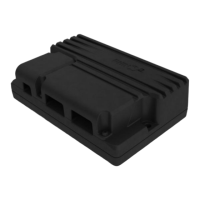Chapter 3: Installation and Testing
3.4 Battery Connections
Note: Images shown are for the –ACT units. Position of
battery terminals for non –ACT units are identical.
Minimum Wire
Gauge
(see notes
below)
DS90: 2 x 3mm
2
(2 x12 AWG)
DS120: 2 x 3mm
2
(2 x 12AWG)
DS160: 2 x 5mm
2
(2 x 10AWG)
DS90: 2 x 3mm
2
(2 x12 AWG)
DS120: 2 x 3mm
2
(2 x 12AWG)
DS160: 2 x 5mm
2
(2 x 10AWG)
Mating Connector Part Numbers DS90, DS90-ACT, DS120, DS120-ACT
6W Housing 250 Series Plug
V0
Mating Connector Part Numbers DS160, DS160-ACT
Crimp terminal M5 ring yellow
10-12AWG
The wire gauge recommendations given above are the MINIMUM gauge and are generally
suitable for runs up to 800mm. Longer runs will require heavier wire – typically an extra 1.0mm
2
for each additional 400mm run length. The heavier the wire, the better driving performance
will be. These notes are in addition to the General Wiring Recommendations as described in
Section 3.3.1.
The final connection to the Battery Positive (+) terminal should not be made until the
scooter is completely wired and ready for testing as described in the Testing section.
The RHINO2 has been designed to perform optimally with multiple battery types (see
below). By default Lead-Acid Gel Cell or AGM 24 V deep cycle batteries rated
between 30 - 120Ah are to be used.
To comply with ISO requirements, a red wire for the Battery Positive must be used.
This must be the only use of a red wire in the controller installation.
The torque settings for the DS160, and DS160-ACT unit battery terminal’s screws
should be between 4.5Nm and 5.5Nm. For DS90, DS90-ACT, DS120, and DS120-ACT
units, it is essential that at least four (2 pairs) battery terminals are used.

